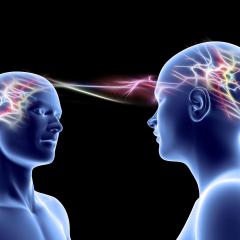
We speak of “mind to mind” transmission of the Dharma. This can be confusing. I remember hearing that a rumor circulated among the students of a well-known abbot: The act of teaching transmission, supposedly, involved the teacher pouring something special into the successor’s brain by means of them sitting for a long time with their heads pressed together.
Even if we aren’t as literal-minded as that, the fact that teaching transmission traditionally happens in a ceremony conducted at midnight, privately and in the teacher’s own quarters, may get us thinking that some thing in the mind has been mysteriously transferred.
Much more helpful, I believe is Keizan’s phrasing (see Part (1)) of “mutual recognition” in the room. In modern lingo, we might say that the teacher and student have found themselves to be “on the same wavelength,” and that transmission involves formal recognition of this.
In Zen Sand, Victor Sogen Hori uses the phrase “mind to mind” in explaining the history of koans. He explains that koan practice has its roots in a very old Chinese literary game. One person would state a line of poetry, laden with allusion and analogy. The next player was challenged to “recognize the hidden meaning of the other person’s allusions and…thrust back using a similar allusion with some other hidden meaning.” In Zen koan work with a teacher, the teacher (or the curriculum) makes the first move. The student, rather than being asked to explain the hidden meaning (i.e., intellectually discoursing about “form,” “emptiness,” “non-duality,” etc.) is invited “to become one with the koan, to be the sound of one hand.” That is, the student is invited to express an opening that cannot be described in ordinary language.
In some traditions, Zen teachers require that the student come up with a literary or original “capping phrase,” even more closely mimicking the Chinese game.
Joan Sutherland in Through Forests of Every Color also talks about koan work communicating experiences “incommunicable in ordinary ways.” She writes about koans being “precisely accurate, a language native to” the place to which one has opened. “As we gradually rejoin a life already in progress,” she writes, “the koans are a kind of traveler’s phrasebook for the journey back into a familiar world seen with new eyes.”
What Hori and Sutherland write about koans, which are more commonly used in the Rinzai school of Zen, also rings true regarding studying the teachings of Eihei Dogen, founder of the Soto school. Dogen’s writings tend to be so dense, obscure, and confusing that our sangha’s periodic Dogen study groups are familiarly known as “Dogen Support Groups.” Yet I have had the experience of finding a particular passage of his suddenly “opening up” for me accompanied by the thought, “He couldn’t possibly have expressed things more clearly!”
Understood this way, “mind to mind transmission” is not about the teacher passing something on to the student. Instead, the teacher by prodding and coaching helps the student come to their own experience of the mysterious dark vastness of our interdependent, lively and vital existence. The student then, by their presentation of a koan or other means, demonstrates that their candle is now lit. The student recognizes the lit candle of the teacher, and the teacher the lit candle of the student.
Or to use a modern metaphor of radio transmission, the “mutual recognition in the room” is not a matter of the teacher actively broadcasting and the student passively receiving. A better image is two people listening to music on the radio, each through their own earbuds. They can’t hear what the other is hearing, and neither can name the piece or the call numbers of the station. But as they individually dance to the music it becomes apparent that they are both tuned into the same Dharma “station.”
Yet, as mentioned earlier, opening experiences by themselves don’t make teachers, nor does a teacher’s confirmation of an opening experience. So the question of “What is transmitted in teacher transmission?” is still not answered.
Introduction: What is Transmitted in Zen Teaching “Transmission”?
Previous post: (1) Enlightenment?
Next post: (3) Patriarchal Authority?